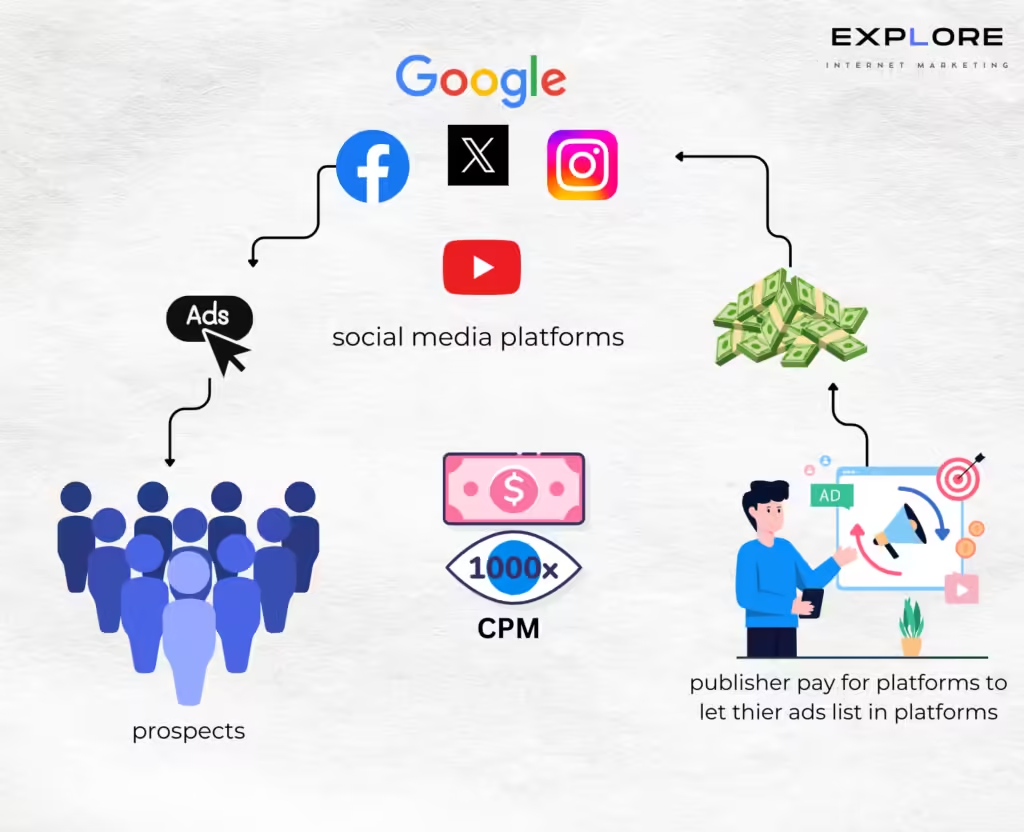Table of Contents
CPM stands for “Cost Per Mille,” where “mille” is the Latin word for “thousand.” In marketing, CPM represents the cost per 1,000 impressions of an ad. This model is commonly used as a metric in advertising bidding systems, particularly in internet marketing. CPM is one of several pricing models available in paid advertising, alongside other methods like CPC (Cost Per Click) and CPA (Cost Per Action), allowing advertisers to select the model that best aligns with their campaign goals.
What is the Formula for CPM?
CPM, or Cost Per Mille, is calculated to determine how much an advertiser spends per 1,000 impressions of an ad. It’s a widely used metric in digital advertising to measure the cost-effectiveness of ad campaigns, particularly when the focus is on visibility rather than direct actions like clicks or conversions.
The formula for calculating CPM is:
![]()
This means the advertiser is paying  500 on a campaign that generates 100,000 impressions, the CPM would be calculated as follows:
500 on a campaign that generates 100,000 impressions, the CPM would be calculated as follows:
![]()
Why CPM is Useful ?
CPM is particularly useful for brand awareness campaigns, where the goal is to reach a large audience rather than drive immediate clicks or actions. It allows advertisers to compare the cost of reaching 1,000 people across different platforms or campaigns, making it easier to budget and optimize for maximum visibility.

Before diving deeper, it’s essential to understand several fundamental marketing terms. These metrics not only provide insights into campaign performance but also help in refining strategies to optimize reach, engagement, and conversion.
Top Marketing Metrics Every Beginner Affiliate Marketer Needs to Know
In marketing, your ultimate goal is to make a profit by driving traffic and conversions through your content. But how do you know if your campaigns are working, or if you’re just burning money? The answer lies in understanding key marketing metrics. These terms might seem intimidating at first, but they’re essential tools to track your progress, make data-driven decisions, and boost your success. Let’s break down the top marketing metrics beginner marketers should know and use.
1. Click-Through Rate (CTR)
CTR shows how many people clicked on your affiliate link or ad compared to the number of people who saw it. High CTRs mean your content is doing a great job grabbing attention, which is crucial in affiliate marketing. A well-placed link in your blog or social media post can boost your CTR, making it more likely that visitors will check out the offer you’re promoting.
![]()
For example, if 100 people saw your affiliate link and 5 clicked on it, your CTR would be 5%.
2. Cost Per Click (CPC)
CPC is the price you pay every time someone clicks on your ad. If you’re running paid ads, you’ll want to track CPC closely to ensure you’re not overspending to drive traffic. A low CPC means you’re getting traffic at a reasonable cost, which is perfect for beginner affiliate marketers working on a budget.
![]()
Say you spent ![]() 0.50, or 50 cents per click. Aim for a low CPC while still reaching the right audience to make the most of your budget.
0.50, or 50 cents per click. Aim for a low CPC while still reaching the right audience to make the most of your budget.
3. Customer Acquisition Cost (CAC)
CAC is the average cost to acquire a customer. As an affiliate marketer, you’re not necessarily acquiring customers directly, but CAC is useful for gauging how much you’re spending on leads or conversions. Knowing your CAC helps you measure your campaign’s cost-effectiveness and ensures you’re spending wisely.
![]()
For instance, if you spent ![]() 30 per customer. Keep CAC in check to ensure you’re getting a good return on your investment.
30 per customer. Keep CAC in check to ensure you’re getting a good return on your investment.
4. Cost Per Lead (CPL)
In affiliate marketing, generating leads is often part of the process—think collecting emails or getting someone to sign up through your link. CPL tells you how much it costs to get each lead and is crucial for campaigns focused on lead generation rather than direct sales. A low CPL means you’re generating leads cost-effectively, increasing your potential for future conversions.
![]()
If you spent ![]() 5 per lead.
5 per lead.
5. Return on Ad Spend (ROAS)
ROAS is essential for affiliates running paid ads. It tells you how much revenue each dollar of ad spend generates. This metric is your profitability compass—higher ROAS means more revenue from your ad investment. Beginners should aim for a ROAS of 3x or more, meaning you’re earning three times what you spend on ads.
![]()
6. Pay-Per-Click (PPC)
PPC is a popular advertising model in affiliate marketing. You pay only when someone clicks on your ad, making it budget-friendly for beginners. With Pay per click, you control your spending and ensure that your budget is focused on generating clicks—just make sure your landing pages are optimized for conversions.

7. Return on Investment (ROI)
ROI is the ultimate measure of profitability. It tells you the return from all your marketing efforts, not just ads. Beginners should use ROI to evaluate the overall success of a campaign and identify what’s worth repeating. Positive ROI means your campaigns are bringing in more than they cost—a great sign that you’re on the right track.
![]()
If your campaign brought in ![]() 500, your ROI is 100%, meaning you’ve doubled your investment.
500, your ROI is 100%, meaning you’ve doubled your investment.
Final Thoughts
Understanding these key metrics will help you make data-driven decisions, optimize your budget, and increase your affiliate marketing earnings. As a beginner, focus on building your knowledge of these metrics, testing different strategies, and learning from the results. With time, tracking and optimizing these numbers will become second nature, setting you up for long-term success.
Pingback: Unlock the Power of Email Marketing: A Beginner’s Guide for Affiliate Marketers